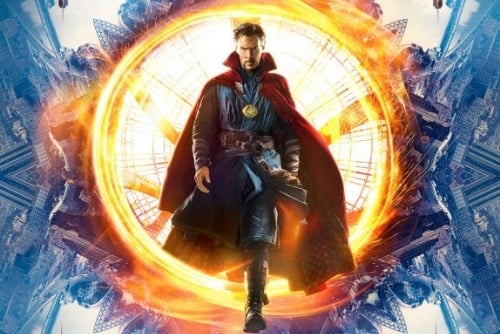A movie review of
Doctor Strange
Directed by Scott Derrickson
(Marvel Studios, 2016)
Doctor Strange is perhaps the most philosophically and religiously fertile Hollywood movie since The Matrix. Both films feature numerous references to a wide variety of worldviews, religions, and philosophies. As with The Matrix, Christian attitudes toward Doctor Strange are likely to be varied. Philosophically oriented viewers will be attracted to the film’s critique of materialistic scientism and its references to Christian themes. But apologists who have more experience dealing with New Age ideologies will be wary of the movie’s attempt to borrow ideas, images, and even practices from the occult and other non-Christian sources.
Dr. Stephen Strange is a comic book superhero whose powers come from what he calls “the mystic arts.” He was once an egotistical surgeon who suffered debilitating nerve damage in a car accident. After exhausting every possible rehabilitative treatment, Dr. Strange turns to Eastern medicine and philosophy. He becomes a disciple of a guru called the Ancient One who teaches him how to manipulate mystical “energies.”
Most of the magic in Doctor Strange is of the relatively harmless and unrealistic Harry Potter variety. For example, the “sorcerers” in the film create mystical swords and shields out of spiritual energy by wiggling their fingers around. They don’t invoke spirits to receive power the way real-life occult practitioners do. This fact is interesting because the portrayal of the occult in the original comic books from the 1960s was more “realistic” in that it did depict Dr. Strange chanting incantations and calling upon spirits. This change is not an accident. Doctor Strange writer-director Scott Derrickson is an outspoken Christian known primarily for making horror films with religious themes such as The Exorcism of Emily Rose and Deliver Us from Evil. Here he seems to have intentionally left out the more dangerous elements of the occult.
Spiritual Realities. But Doctor Strange still references some key New Age terms and ideas, most obviously Astral Projection, the attempt to intentionally separate one’s spirit from one’s body. This can be a dangerous practice in real life and can set the impressionable seeker down the wrong path. I think Derrickson kept it in the film despite the dangers partly because he wanted to portray the existence of the soul. Derrickson consistently creates movies that depict spiritual realities. Doctor Strange never mentions God or Jesus, but the film takes place in a world where the soul is real, as are evil, sin, and salvation.
In fact, one of the central themes of the film is that the universe is more than just material bodies made of atoms. At the beginning of the film, Dr. Strange only believes in science and rejects the reality of the spirit. But after he experiences astral projection for himself, he can no longer adhere to strict materialism. Yet Derrickson also wants to avoid the New Age idea that the body is merely an illusion. Instead, he portrays the Christian view: body and soul are both real and are interconnected so that they affect each other. When Dr. Strange is in his “astral form” (separated from his body) and fighting another sorcerer’s astral form, we see that harming his sprit has an effect on his body, but also vice versa. The shock from a defibrillator on his dying body has an effect on his spirit as well.
Thus Doctor Strange critiques both atheistic materialism and New Age mysticism. We see the same dual critique in the film’s attitude toward death. Whereas Dr. Strange initially espouses the atheistic view that his life is merely a “tiny, momentary speck within an indifferent universe,” New Age mysticism claims instead that death is an illusion, since the soul is continuously reincarnated until it learns to become eternally “one” with the entire universe. Derrickson rejects this desire for oneness as a false attempt of humans to achieve eternal life apart from God.
The film’s villain, a demon called Dormammu, explicitly offers his followers eternal life by transcending space and time to become one with all things. Here Dormammu is describing what New Age thinkers call “cosmic consciousness,” which aims to make people one with God in a kind of pantheistic monism. But Dr. Strange’s guru warns him that this sort of “eternal life” would be “not paradise but torment.” She tells him that “death is what gives life meaning,” which I take to mean that if everything is “one,” then there can be no distinction between good and evil, and hence no meaningful choices. This is an implication that Dormammu’s disciple Kaecilius explicitly affirms in the film. The character of Dormammu seems like a pretty clear reference to Satan, who promises his followers, “Ye shall not surely die…and ye shall be as gods” (Gen. 3:4–5).
Strange Sorcery. Thus this is a world where evil is real. Magic allows Dr. Strange to open up “portals” to other dimensions, but the Ancient One warns him that while some worlds are “benevolent and life-giving, others [are] dark places filled with malice and hunger” for destruction. She teaches her followers that they must work within “the natural law.” This seems to refer to the laws of nature, but the film gives it a moral weight. They have the power to break the laws of nature, but they are not allowed to break them. Though the implication is left unstated in the film, it seems to be clear enough: these laws have been given to them by a Designer (God) for their own good.
The Ancient One’s library contains certain forbidden books, including the book that describes how to summon Dormammu. Kaecilius steals this book in the film’s opening scene. When Strange asks about these books, the librarian tells him, “No knowledge is forbidden, only certain practices.” But practice without knowledge can be deadly. At one point, Strange starts performing a ritual described in a book without reading all the way to the end where the book describes the dangers of the ritual. It is telling that he is eating an apple during this scene—a reference to the Garden of Eden’s forbidden fruit. Derrickson is attempting to warn his viewers not to take occult practices lightly. Watching them in a film is one thing; acting them out is another.
Unfortunately, not all viewers will heed such warnings. Parents will want to exercise caution with Doctor Strange. It is ultimately closer to Dungeons & Dragons than it is to Harry Potter. Those in campus ministries, however, might be able to use the film to open conversations about theological ideas.
For Derrickson, as for St. Augustine, the root of all sin is pride (and the desire for control), which means our salvation is found in surrendering control of our will to God. The Ancient One challenges Dr. Strange to “elevate” his mind so that he can see “the greater good” and devote his life to something larger than himself. This is a lesson Dr. Strange learns during his climactic battle with Dormammu in which he performs perhaps the first selfless act in his life, offering his own life in exchange for the world. Derrickson has transformed the sorcerer Stephen Strange into a Christ figure.
Doctor Strange diagnoses both scientism and New Age mysticism as having the same problem. They both think the most important thing in the universe is me. Science devolves into a pursuit of human mastery over nature, and the so-called spirituality of the New Age becomes all about self-help books that tell me I can be God. To both of these mistaken worldviews, Derrickson has the Ancient One quote Rick Warren’s Purpose Driven Life: “It is not about you.”
John McAteer is associate professor at Ashford University, where he serves as the chair of the liberal arts program. Before receiving his PhD in philosophy from the University of California at Riverside, he earned a BA in film from Biola University and an MA in philosophy of religion and ethics from Talbot School of Theology.









